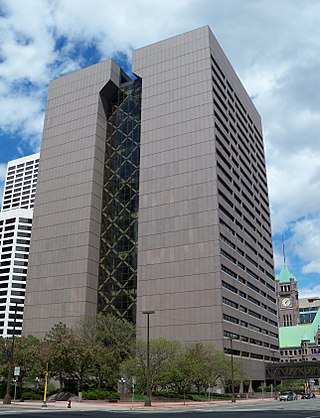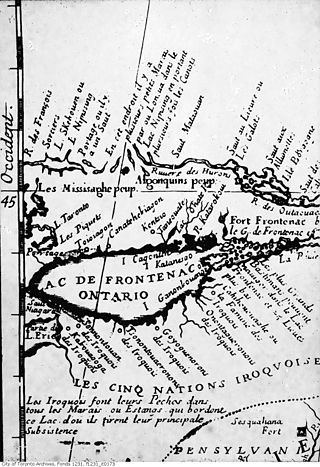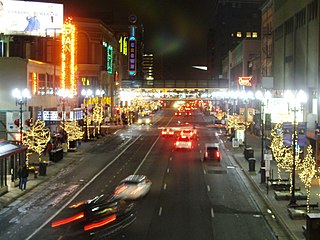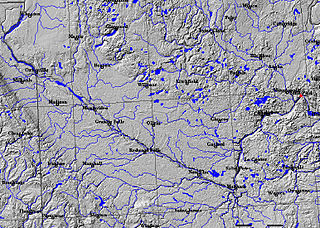Related Research Articles

The Mississippi River is the primary river, and second-longest river, of the largest drainage basin in the United States. From its traditional source of Lake Itasca in northern Minnesota, it flows generally south for 2,340 miles (3,766 km) to the Mississippi River Delta in the Gulf of Mexico. With its many tributaries, the Mississippi's watershed drains all or parts of 32 U.S. states and two Canadian provinces between the Rocky and Appalachian mountains. The main stem is entirely within the United States; the total drainage basin is 1,151,000 sq mi (2,980,000 km2), of which only about one percent is in Canada. The Mississippi ranks as the thirteenth-largest river by discharge in the world. The river either borders or passes through the states of Minnesota, Wisconsin, Iowa, Illinois, Missouri, Kentucky, Tennessee, Arkansas, Mississippi, and Louisiana.

Hennepin County is a county in the U.S. state of Minnesota. Its county seat is Minneapolis, the state's most populous city. The county is named in honor of the 17th-century explorer Father Louis Hennepin. The county extends from Minneapolis to the suburbs and outlying cities in the western part of the county. The county's natural areas are covered with extensive woods, hills, and lakes.

Lake City is a city in Goodhue and Wabasha counties in the U.S. state of Minnesota. It lies along Lake Pepin, a wide portion of the Mississippi River. The population was 5,252 at the 2020 census. Most of Lake City is located within Wabasha County with only a small portion in Goodhue County. Lake City is part of the Rochester, Minnesota Metropolitan Statistical Area.

Saint Anthony Falls, or the Falls of Saint Anthony, located at the northeastern edge of downtown Minneapolis, Minnesota, is the only natural major waterfall on the Mississippi River. Throughout the mid-to-late 1800s, various dams were built atop the east and west faces of the falls to support the milling industry that spurred the growth of the city of Minneapolis. In 1880, the central face of the falls was reinforced with a sloping timber apron to stop the upstream erosion of the falls. In the 1950s, the apron was rebuilt with concrete, which makes up the most visible portion of the falls today. A series of locks were constructed in the 1950s and 1960s to extend navigation to points upstream.

Louis Hennepin, O.F.M. was a Belgian Catholic priest and missionary of the Franciscan Recollet order and an explorer of the interior of North America.
Daniel Greysolon, Sieur du Lhut was a French soldier and explorer who is the first European known to have visited the area where the city of Duluth, Minnesota, United States, is now located and the head of Lake Superior in Minnesota. His name is sometimes anglicized as "DuLuth", and he is the namesake of Duluth, Minnesota, as well as Duluth, Georgia. Daniel Greysolon signed himself "Dulhut" on surviving manuscripts.
Michel Aco was a French explorer who, along with René Robert Cavelier, Sieur de La Salle and Father Louis Hennepin, explored the Mississippi River in 1679. Aco became La Salle's lieutenant because of his knowledge of Native American languages and his abilities as an explorer. When the party reached the Illinois River; Aco, Hennepin and another man were sent to explore the upper Mississippi. During their exploration, they became the first Europeans to see Carver's Cave and Saint Anthony Falls. They were later captured by Sioux Indians and held until the influence of Daniel Greysolon, Sieur du Lhut won their release. He was brought to the mouth of the Wisconsin River and went on to explore the Wisconsin River, the Fox River down to Green Bay, Wisconsin, and Mackinac Island, Michigan, and finally, in 1681, to Montreal. After his exploring days were over, Aco settled in Illinois and became a trader. He married Aramepinchieue, the daughter of a Kaskaskia chief in 1693, and had two children with her.

Teiaiagon was an Iroquoian village on the east bank of the Humber River in what is now the York district of Toronto, Ontario, Canada. It was located along the Toronto Carrying-Place Trail. The site is near the current intersection of Jane Street and Annette Street, at which is situated the community of Baby Point.

The Hennepin Avenue Bridge is the structure that carries Hennepin County State Aid Highway 52, Hennepin Avenue, across the Mississippi River in Minneapolis, Minnesota, at Nicollet Island. Officially, it is the Father Louis Hennepin Bridge, in honor of the 17th-century explorer Louis Hennepin, who was the first European to see the Saint Anthony Falls, a short distance downriver. Two of the three previous structures have been suspension bridges, while a third—which existed nearly a century—was composed of steel arch spans. The original crossing, which opened as a toll bridge on January 23, 1855, is believed to have been the first permanent span across the Mississippi at any point. Other bridges were completed in 1876, 1891, and most recently 1990. Today, the bridge's main span is 190 metres (620 ft) in length.

Father Hennepin State Park is a state park of Minnesota, USA, located on the southeast corner of Mille Lacs Lake. The park is named after Father Louis Hennepin, a priest who visited the area with a French expedition in 1680. The 320-acre (130 ha) park has 103 campsites and a sandy beach over one mile (1.6 km) long.

The Rum River is a slow, meandering stream that connects Minnesota's Mille Lacs Lake with the Mississippi River. It runs for 151 miles (243 km) through the communities of Onamia, Milaca, Princeton, Cambridge, Isanti, and St. Francis before ending at the city of Anoka, roughly 20 miles northwest of Minneapolis. It is one of the six protected Wild and Scenic rivers in Minnesota.

Hennepin Avenue is a major street in Minneapolis, Minnesota, United States. It runs from Lakewood Cemetery, north through the Uptown District of Southwest Minneapolis, through the Virginia Triangle, the former "Bottleneck" area west of Loring Park. It then goes through the North Loop in the city center, to Northeast Minneapolis and the city's eastern boundary, where it becomes Larpenteur Avenue as it enters Lauderdale in Ramsey County at Highway 280. Hennepin Avenue is a Minneapolis city street south/west of Washington Avenue, and is designated as Hennepin County Road 52 from Washington Avenue to the county line.

Saint Anthony West is a neighborhood in the Northeast community of Minneapolis.
Minneapolis is the largest city in the state of Minnesota in the United States, and the county seat of Hennepin County.

The River Warren Falls was a massive waterfall on the glacial River Warren initially located in present-day Saint Paul, Minnesota, United States. The waterfall was 2700 feet (823 m) across and 175 feet (53 m) high.

Hennepin County Library is a public library system serving Hennepin County, Minnesota, US. The current iteration of Hennepin County Library was formed by the merger of urban Minneapolis Public Library and suburban Hennepin County Library on January 1, 2008. The system has 41 library locations, deposit collections at nursing homes and correctional facilities, mail service to the homebound, and extensive outreach services. The library is a department of Hennepin County Government. The library headquarters are in the Ridgedale Library in suburban Minnetonka. The library system has an eleven-member advisory Library Board appointed by the Hennepin County Board of Commissioners. It is a member of the Metropolitan Library Service Agency, a consortium of eight Twin Cities library systems.

The Eastman tunnel, also called the Hennepin Island tunnel, was a 2,000-foot-long (610 m) underground passage in Saint Anthony, Minnesota, dug beneath the Mississippi River riverbed between 1868 and 1869 to create a tailrace so water-powered business could be located upstream of Saint Anthony Falls on Nicollet Island. The tunnel ran downstream from Nicollet Island, beneath Hennepin Island, and exited below Saint Anthony Falls.

Fort Crevecoeur was the first public building erected by Europeans within the boundaries of the modern state of Illinois and the first fort built in the West by the French. It was founded on the east bank of the Illinois River, in the Illinois Country near the present site of Creve Coeur, a suburb of Peoria, Illinois, in January 1680. It was destroyed on April 16, 1680 by members of La Salle's expedition, who mutinied and abandoned it, fearful of being attacked by the Iroquois League as the Beaver Wars extended into the area.
The French language has been spoken in Minnesota since the 17th century, being the first European language to be brought to the area.

St. Anthony's Rock is a geological limestone sea stack and tourist attraction located in the central part of the city of St. Ignace, Michigan in Michigan's Upper Peninsula.
References
- ↑ "Minnesota History - Early Explorers". mnhistory.weebly.com. Retrieved 2019-08-09.
- ↑ Willis, John W. (1910). . In Herbermann, Charles (ed.). Catholic Encyclopedia . Vol. 7. New York: Robert Appleton Company. p. 215.